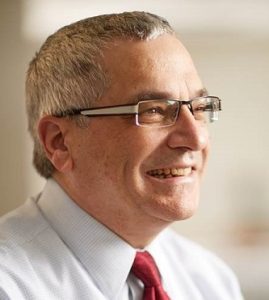
Low back pain is the leading cause of disability worldwide and becomes increasingly common as human bodies age. Currently, more than 40 percent of low back pain patients are prescribed opioids at some point. Researchers at Pitt want to bring that number down.
“You would have to be living under a rock to not know we have an opioid crisis in the United States,” said Mike Schneider, DC, PhD, an associate professor in the University of Pittsburgh’s School of Health and Rehabilitation Sciences. “Some people are extremely susceptible and can show dependency after just a few doses. What’s sad is that some people think this crisis is just poor, uneducated people. It’s not.”
To figure out ways to decrease prescriptions and treat pain appropriately, Dr. Schneider and colleagues at Pitt are part of a five-year, $11.2 million study funded by the National Institutes of Health that will test non-drug approaches to treating and preventing chronic low back pain. Dr. Schneider, who teaches in the Department of Physical Therapy and the Clinical and Translational Science Institute, will serve as a co-principal investigator for a large multicenter clinical trial examining the effectiveness of spinal manipulation and supported self-management, compared to usual medical care. McGowan Institute for Regenerative Medicine affiliated faculty member Anthony Delitto, PhD, Professor and Dean of the School of Health and Rehabilitation Sciences at the University of Pittsburgh and Director of the Comparative Effectiveness Research Center for the University of Pittsburgh and UPMC, is also a co-principal investigator.
In Pennsylvania alone, 4,642 drug-related overdose deaths were reported in 2016 by coroners and medical examiners, an increase of 37 percent from 2015, according to a joint report by the Drug Enforcement Agency’s Philadelphia Division and the University of Pittsburgh.
“For cancer pain and post-operative care, people need opioids because they’re in very serious pain. But it’s surprising how often opioids are prescribed for acute back pain,” Dr. Schneider said.
Pitt’s role in the study is to be a physical therapy site, while the University of Minnesota will be a chiropractic site, and the University of Washington will assume a data management role. A total of 1,180 patients will take part in the study, with enrollment beginning next spring. Dr. Schneider said about 650 patients will be treated at the Pittsburgh site.
The researchers will compare spinal manipulation and supported self-management to usual medical care, which includes prescription medications for the care of acute lower back pain in adult patients at increased risk of becoming chronic.
Supported self-management includes self-care strategies that address the biological, psychological, and social aspects of back pain through the use of behavioral and coping strategies, mind-body approaches, lifestyle advice, and pain education.
The hope is that, by investigating the sources of pain, doctors can treat new episodes of back pain without prescriptions and intervene before back pain becomes a long-term problem.
“What we’re looking at is how this will affect opioid use, and that specific research question has not been looked at previously,” Dr. Schneider said. “We also want to look at whether or not we can prevent an acute episode of back pain from turning chronic.”
Non-medicinal methods of treating back pain have been gaining support in recent years.
New guidelines from the American College of Physicians state that these non-medicinal methods should be the first option to treating back pain. If medication is required for pain management, the guidelines state that non-steroidal medicines should be prescribed. Opioids are considered to be a last-resort option. The Centers for Disease Control and Prevention also published a report in 2016 acknowledging the risk of prescribing opioids to patients experiencing chronic pain.
“For the first time, we’re seeing things like spinal manipulation, yoga, tai chi, and all sorts of non-pharmacological treatments previously considered quackery or pseudoscience have evidence that show they can work,” Dr. Schneider said. “And they certainly don’t have the side effects of medication. But it’s going to take a while for the average American and American doctor to be recommending these treatments.”
Read more…
